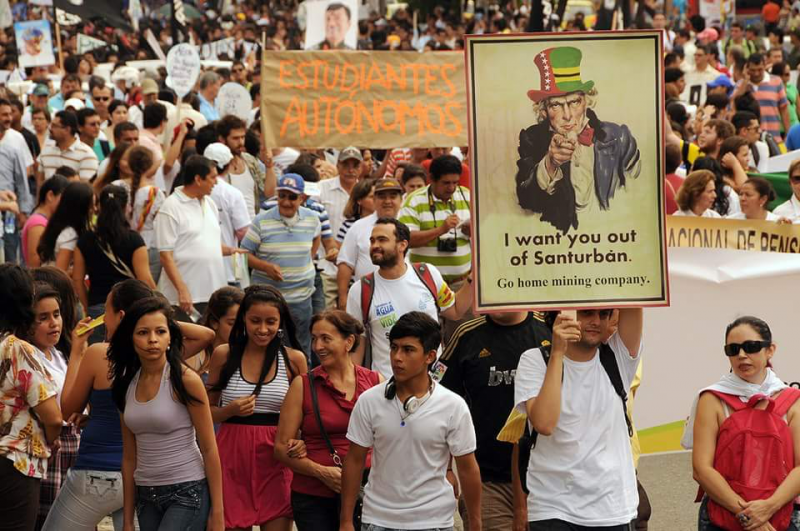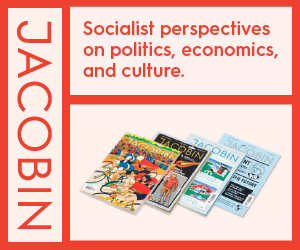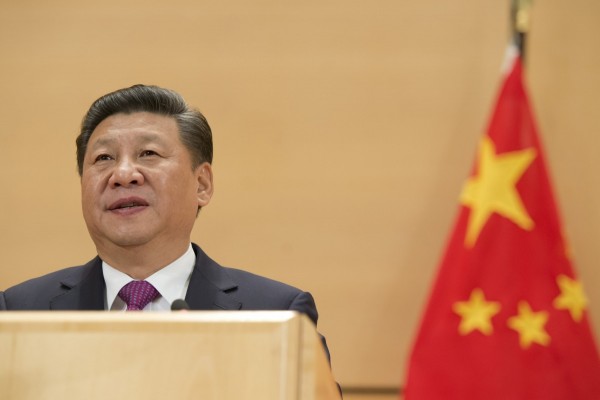Canadian mining companies and the making of modern Colombia
Canadian PoliticsLatin America and the CaribbeanUSA Politics

In February 2011, thousands of activists marched in several Colombian cities against the controversial Angostura project proposed by Canadian mining junior Greystar Resources. The International Finance Corporation, the private lending arm of the World Bank, was pressured to divest from the project in 2017. Photo by Óscar Sampayo.
Although there will surely be a change of tone and civility with the incoming Joe Biden administration, one thing is certain: there will be absolutely no change to the United States’ foreign policy relationship with Latin America, sometimes referred to as the Monroe Doctrine.
Imperialism in Latin America is a bipartisan feature of the US state. Intervention increased during the Cold War under the justification of anti-communism, but since then, America’s reasons for involvement have been continually adapted, from the war on drugs to the war on terror, and now to the war on Chinese business (see the great powers’ recent clash over investment in El Salvador).
The true reason for intervention is that the region’s natural resources are irresistible to transnational capital, and not just capital based in the US. Canadian mining and energy companies have taken advantage of the free trade policies encouraged by Washington in order to extract profits from the region while ignoring—or in some cases contributing to—the most atrocious human rights records in the hemisphere, particularly in Colombia.
By situating the role of the US-Canadian geopolitical alliance in the creation of the modern Colombian free-trade terror state, one acquires a much clearer picture of Colombian politics and broader North American interventions in Latin America over the course of the last half century.
La Violencia and the creation of the ‘morbid symbiosis’
Campaign appeals to Florida are always trite affairs, little more than competitions to decide who can gurgle up the most tired anti-left clichés, but they offer revealing insights into the American ruling class’s harmful and sclerotic approach to Latin America.
A notable beneficiary of this year’s Florida episode was Colombia’s far-right government (described as the “keystone” of US policy in Latin America by Joe Biden) and particularly former president Alvaro Uribe, who has been hailed as a “hero” by Donald Trump. Uribe is currently being investigated for his alleged involvement in multiple paramilitary massacres. He is also the mentor of current president Iván Duque, whose administration has presided over the killings of hundreds of activists, “relentless violence” against former FARC fighters, police attacks on peaceful protestors, and a woefully incompetent COVID response.
In his attempt to appeal to Colombian-American voters, Biden penned an op-ed in October for the Bogota-based newspaper El Tiempo in which he wrote not about the ongoing epidemic of massacres and state brutality under the Duque administration, but about the 1985 Palace of Justice siege committed by M-19, a guerilla group active in 1970s and 1980s.
“I’ll never forget seeing on the news the brazen attack on Colombia’s Palace of Justice in 1985 by M-19 guerrillas,” Biden wrote. “The injustice of gunning down judges with impunity. The cowardice of those criminals who feared extradition to face trial in the United States.”
There is, of course, no mention of the fact that the army’s heavy-handed response to the hostage situation caused the deaths of almost 100 civilians, and is referred to as a “holocaust” by many Colombians.
The American ruling class’s acceptance (and often encouragement) of the constant death and suffering meted out by the Colombian state is a disgrace. Of course, what matters most from the perspective of America is the dominance of US or US-aligned capital, and in that regard the government has been a reliable partner since the protracted horrors of modern Colombia were forged in the fires of La Violencia. The forming of the National Front in 1958, a power-sharing agreement in which the Liberal and Conservative parties set aside their petty ideological squabbles in order to protect their class interests, established the fronts of the six-decade long conflict which is still active to this day: the state versus the leftist guerrilla movements predominantly concentrated in the rural south.
By 1959, large sections of southern farmland were under the control of autonomous peasant communities. Many of these rural workers had supported Jorge Eliécer Gaitán, the populist presidential candidate whose assassination was the inciting event of La Violencia. It was during the six-year period from 1959 to 1965 that the origins of American involvement in Colombia were established, and the morbid symbiosis of the two countries’ ruling classes was entrenched. America’s interest, as always, was cruelly capitalistic: they feared that a peasant-led revolution would jeopardize the benefits they reaped from the nearby Panama Canal in the form of a socialist government hostile to the US. Of course, it should be obvious to any student of Latin American history that “hostile to the US” actually means hostile to investment by the US and its allies.
A mural reading “Water is worth more than gold” protesting a Barrick mining project. Photo by Amilcar/Flickr.
The Canada-Colombia Free Trade Agreement
Canada also has a relevant history of military and economic cooperation with the Colombian state. In 1963, the Canadian Armed Forces and Department of National Defence started the Military Training and Cooperation Program (MTCP), an initiative “aimed at providing military advisors and training assistance to select, newly-independent Commonwealth countries.” Through this program, the Canadian military has trained thousands of soldiers across Latin America and the Caribbean. Since 2011, 239 Colombian officers have received training through the MTCP, and according to the Canadian embassy to Colombia, “the Colombian armed forces have access to training in areas that promote Canadian democratic principles.”
Significant economic engagement between the two countries began in 2007 with the announcement of Prime Minister Stephen Harper’s new “Americas Policy,” which saw Canada expand trade ties with countries that shared the values of “democracy, human rights, rule-of-law and good governance.” As the Colombia Working Group (CWG) writes, “the Canadian government then announced negotiations for a free trade and investment deal with Colombia, the country with the worst human rights record in the hemisphere.”
In 2011, the Canada-Colombia Free Trade Agreement (CCoFTA) was passed as part of Harper’s new project. This agreement was signed in the context of the Pink Tide, when many strong left-wing governments were challenging typical power relations between US-led global capitalism and Latin American economies. The CCoFTA was in part a reaction against Pink Tide economics, and an attempt to impose the neoliberal template of NAFTA upon additional Latin American countries.
Colombia’s human rights record did not impede Canada’s involvement. At the time of the agreement’s signing, “brutal paramilitary gangs proliferated, murders of trade unionists continued, and peasants, Indigenous and Afro-descendent communities were forcibly displaced from their ancestral homes.” By 2015, the killing of trade unionists had a shocking 90 percent impunity rate.
The Special Survey Team of 1959
In 1959, at the request of President Lleras Camargo—who later became the first Secretary General of the Washington-based Organization of American States—the US State Department sent a Special Survey Team to advise the Colombian government on the most effective ways to destroy the independent peasant republics. The team (described here in glowing terms by Dr. Charles H. Briscoe, a historian for the US Army’s Special Operations Command) was a rogues’ gallery of anti-communist Cold Warriors. The leader, Hans Tofte, worked as a trouble-shooter for CIA director Walter Bedell Smith and also trained guerrilla forces during the Korean War. Other members included Joseph J. Koontz, who had served as a military advisor to the Colombian government during La Violencia, as well as Charles Bohannon and Napoleon Valeriano, both of whom were considered successful counterinsurgency planners due to their role in crushing the Hukbalahap uprising in the Philippines.
The Special Survey Team discovered that hundreds of thousands of Colombians had died during the ten-year war, more than one million people had been displaced, and the military and police remained distrusted by the rural population. Their final report was packed with recommendations for reform. Among their suggestions were the creation of irregular counter-guerrilla forces called Lanceros, the introduction of covert psychological warfare capabilities and new counterintelligence operations, and the establishment of civil affairs programs to rehabilitate the public image of the Washington-aligned military and police. The team estimated that the violence would be over within 10 to 12 months.
For many people the term “counterintelligence” is a rather vague concept, and thus a short analysis of America’s CI strategies can prove instructive. A 1962 Special Forces manual outlines the pillars of US counterintelligence training: guerrilla warfare, propaganda, subversion, intelligence and counter-intelligence, terrorist activities, civic action, and conventional combat operations. Another manual entitled Stability Operations attempts to systematize resistance behaviors in a section called “Insurgent Activity Indicators.” According to this manual, anti-government insurgents often partook in one or all of the following activities:
Discrediting the judicial system and police organizations… Characterization of the armed forces as the enemy of the people… Increased unrest among laborers… Strikes or work stoppages called to protest government actions. Increase of petitions demanding government redress of grievances. Proliferation of slogans pinpointing specific grievances [and] Initiation of letter writing campaigns to newspapers and government officials deploring undesirable conditions and blaming individuals in power.
It is clear from this contemporary document that American counterintelligence efforts in Colombia were, from the start, an attempt to facilitate the continued openness of the Colombian economy at the expense of those who had been historically excluded from its benefits. The classification of dissatisfied labourers and strikers as “enemy insurgents” is evidence of this.
Given the actions of the Colombian state in the succeeding decades, it appears that its ruling class still views anybody who is critical of the economic status quo as worthy of merciless retaliation.
Canadian investment since the CCoFTA
Gibraltar 3 well, located in the Eastern Cordillera foothills of Colombia. Photo by Kyle Johnson/Flickr.
In 2011, the mining industry received $6.7 million from the federally-run Canadian International Development Agency (CIDA) for the purpose of “build[ing] local leader capacity and support for mining projects.” The CIDA also gave $20 million to the US government’s Andean Regional Initiative (ARI) in order to “advance NGO partnerships with mining companies in Colombia, Peru and Bolivia.”
In 2014, Export Development Canada (EDC), a crown corporation whose purpose is to encourage Canadian investment in growing markets around the world, gifted $48.5 million to Pacific Rubiales, a crude oil producer with a heinous past. At the time of the EDC’s handout, Pacific Rubiales had the following stains on its record:
condemned by a Colombian court for disregarding prior consultation requirements with Indigenous people… called out for dumping production waste water over the limits permitted by environmental licences… flagrant lapses in accounting, including great disparities between its production reports to investors and figures published by the Colombian Department of Mines and Energy… suing journalists for informing the public about its activities… failing to respect freedom of association and labour rights.
Much like the US, the process of Canadian free trade investment in Colombia was coupled with an expansion of military ties. It was in 2011, the same year of the CCoFTA’s passing, that Colombia joined the MTCP. Furthermore, during peace negotiations with the FARC in 2012, Canada sold 32 troop and combat transportation vehicles to the government and began to export automatic military weapons to Colombia, making it the first Latin American country to receive such arms from the Canadian government.
Plan Lazo
After the Special Survey of 1959, the violence in Colombia predictably ground on. As a result, US General William Yarborough conducted a study in 1962 to supplement the team’s findings. Yarborough described the need to intensify initiatives against the rebels through more organized counterintelligence and paramilitary operations. In his report, he wrote that the Colombian state needed to create a program which could
perform counter-agent and counter-propaganda functions and as necessary execute paramilitary, sabotage and/or terrorist activities against known communist proponents. It should be backed by the United States… The apparatus should be charged with clandestine execution of plans developed by the United States Government toward defined objectives in the political, economic and military fields.
The recommendations of the Special Survey Team and General Yarborough formed the foundation of Plan Lazo. This plan directly identified the autonomous peasant communities in the south as dangerous to US interests and set about funding and arming “civil defense” paramilitaries to eliminate the communities, with a particular focus on the Marquetalia Republic. With support from the US, the paramilitaries and Colombian military (who are alleged to have used napalm against the rebels) destroyed the independent republics. The majority of the peasant leadership escaped, however, and in 1966 the communities formed into two new organizations: the Revolutionary Armed Forces of Colombia (FARC, which has been particularly popular among the dispossessed peasant class) and the National Liberation Army (ELN).
Plan Lazo set up an infrastructure for the expansion of paramilitary violence in Colombia. It was during the implementation of Lazo that President Guillermo León Valencia declared a “state of siege” and passed Decree 3398, which allowed the creation of private military forces to protect the interests of the land-owning class and foreign capital. In 1968, Decree 3398 was permanently institutionalized as Law 48, a piece of legislation that allows the executive office to create civilian patrols by decree and the Defense Ministry to supply them with military-grade weaponry. According to Human Rights Watch, the military has “frequently cited Law 48 as the legal foundation for their support for all paramilitaries.”
Colombia and the US-Canadian alliance today
In 1967 Colombia became the largest recipient of US aid in Latin America, and the close relationship persists to this day. Recent developments in American-Colombian relations are more well-known, such as Plan Colombia (effectively an expansion of Plan Lazo) and the horrific “false positives” scandal that this policy produced, but the roots of so much Colombian terror can be found in the US programs of counterintelligence that were enacted in the aftermath of La Violencia—and in the free market economy which these programs helped solidify.
In 2018, the United Nations High Commissioner for Refugees issued a report that described Colombia as having over 7.7 million internally displaced persons, more than both Syria and the Democratic Republic of the Congo. Furthermore, hundreds of thousands of Colombians have fled their country as refugees. Nevertheless, the Colombian ruling class continues to receive hundreds of millions in foreign aid from the United States and bipartisan praise from the rulers of America.
Since the passing of the CCoFTA, Canada’s cooperation with the Colombian state has not slowed. Today the most active Canadian companies in Colombia are Gran Tierra Energy, Parex Resources, and Canacol Energy (on November 20, Canacol and Parex signed contracts with the Colombian government for four new onshore oil blocks). Pacific Rubiales, which changed its name to Pacific Exploration and Production in 2015 and then to Frontera Energy in 2017, has continued its anti-worker, anti-Indigenous, anti-environment practices in Colombia, and as a result remains an energy powerhouse.
Security collaboration between the two countries continues as well: they have collaborated on anti-terrorism programs, and the RCMP have run officer training programs in Colombia.
Although Canada is not as tactless as US politicians when they appeal to right-wing extremism in Florida, the Canadian government and its extensions of capital are deeply implicated in the Monroe Doctrine’s legacy of military and economic interventionism in Latin America, and their record in Colombia reveals this.
Owen Schalk is a writer based in Winnipeg. His areas of interest include post-colonialism and the human impact of the global neoliberal economy.










